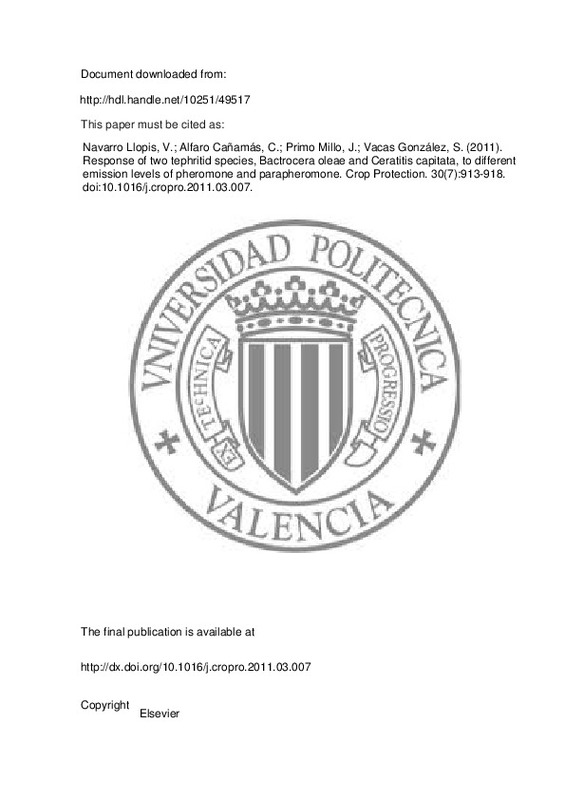JavaScript is disabled for your browser. Some features of this site may not work without it.
Buscar en RiuNet
Listar
Mi cuenta
Estadísticas
Ayuda RiuNet
Admin. UPV
Response of two tephritid species, Bactrocera oleae and Ceratitis capitata, to different emission levels of pheromone and parapheromone
Mostrar el registro sencillo del ítem
Ficheros en el ítem
| dc.contributor.author | Navarro Llopis, Vicente
|
es_ES |
| dc.contributor.author | Alfaro Cañamás, Cristina
|
es_ES |
| dc.contributor.author | Primo Millo, Jaime
|
es_ES |
| dc.contributor.author | Vacas González, Sandra
|
es_ES |
| dc.date.accessioned | 2015-04-30T10:17:14Z | |
| dc.date.available | 2015-04-30T10:17:14Z | |
| dc.date.issued | 2011-07 | |
| dc.identifier.issn | 0261-2194 | |
| dc.identifier.uri | http://hdl.handle.net/10251/49517 | |
| dc.description.abstract | Attractants and pheromones are commonly used in integrated pest management programs in crop systems. However, pheromone dispensers employed in monitoring traps and lure and kill devices are not usually well studied and attractants are released at uncontrolled rates leading to low treatment efficacies and misleading monitoring estimations. Fruit flies are pests of economic importance and monitoring is essential in order to program insecticidal treatments. Moreover, lure and kill techniques are being increasingly used, but the cost of these techniques depends on the number of required traps and, therefore, on the efficacy of the attractants. Ceratitis capitata and Bactrocera oleae are the two main fruit flies in Mediterranean countries, and the effect of different doses of trimedlure and spiroacetal on fly attraction has been studied. Results showed that a release rate over 1.28 mg/day of spiroacetal reduces B. oleae attraction and emission values over 2.4 mg of trimedlure per day did not increase C. capitata catches. Under the environmental conditions of our study, an optimum release rate for pheromone attraction in B. oleae was determined. Emission values over this optimum level reduced B. oleae attraction. However, when a parapheromone was used with C. capitata, a fruit fly of the same family, the optimum emission value was not found and higher quantities of parapheromone attracted the same number of flies. The saturation effect of high concentrations of pheromone and parapheromone is discussed. | es_ES |
| dc.description.sponsorship | We wish to thank "Cartuja de Portacoeli" and Domingo de Guzman Orero for offering their orchards for this research, and Juan Bautista for field assistance. This research was supported by "Ministerio de Ciencia e Innovacion" project number AGL2006-13346-C02-02. | en_EN |
| dc.language | Inglés | es_ES |
| dc.publisher | Elsevier | es_ES |
| dc.relation.ispartof | Crop Protection | es_ES |
| dc.rights | Reserva de todos los derechos | es_ES |
| dc.subject | Ceratitis capitata | es_ES |
| dc.subject | Bactrocera oleae | es_ES |
| dc.subject | Pheromone | es_ES |
| dc.subject | Attractant | es_ES |
| dc.subject | Monitoring | es_ES |
| dc.subject | Lure and kill | es_ES |
| dc.subject.classification | QUIMICA ORGANICA | es_ES |
| dc.title | Response of two tephritid species, Bactrocera oleae and Ceratitis capitata, to different emission levels of pheromone and parapheromone | es_ES |
| dc.type | Artículo | es_ES |
| dc.identifier.doi | 10.1016/j.cropro.2011.03.007 | |
| dc.relation.projectID | info:eu-repo/grantAgreement/MEC//AGL2006-13346-C02-02/ES/CONTROL DE CERATITIS CAPITATA EN CITRICOS. DESARROLLO DE NUEVOS METODOS/ | es_ES |
| dc.rights.accessRights | Abierto | es_ES |
| dc.contributor.affiliation | Universitat Politècnica de València. Centro de Ecología Química Agrícola - Centre d'Ecologia Química Agrícola | es_ES |
| dc.contributor.affiliation | Universitat Politècnica de València. Instituto Agroforestal Mediterráneo - Institut Agroforestal Mediterrani | es_ES |
| dc.contributor.affiliation | Universitat Politècnica de València. Departamento de Química - Departament de Química | es_ES |
| dc.description.bibliographicCitation | Navarro Llopis, V.; Alfaro Cañamás, C.; Primo Millo, J.; Vacas González, S. (2011). Response of two tephritid species, Bactrocera oleae and Ceratitis capitata, to different emission levels of pheromone and parapheromone. Crop Protection. 30(7):913-918. https://doi.org/10.1016/j.cropro.2011.03.007 | es_ES |
| dc.description.accrualMethod | S | es_ES |
| dc.relation.publisherversion | http://dx.doi.org/10.1016/j.cropro.2011.03.007 | es_ES |
| dc.description.upvformatpinicio | 913 | es_ES |
| dc.description.upvformatpfin | 918 | es_ES |
| dc.type.version | info:eu-repo/semantics/publishedVersion | es_ES |
| dc.description.volume | 30 | es_ES |
| dc.description.issue | 7 | es_ES |
| dc.relation.senia | 41462 | |
| dc.contributor.funder | Ministerio de Educación y Ciencia | es_ES |







![[Cerrado]](/themes/UPV/images/candado.png)

